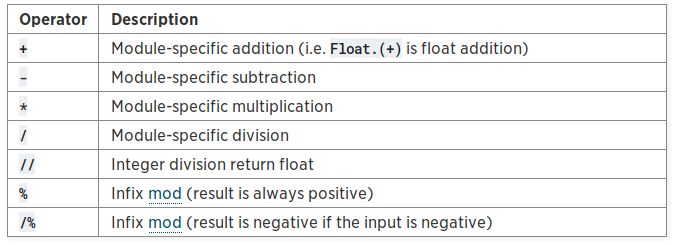By Brendan Long
Originally Published on Jan 16, 2018
One of the hardest parts of learning OCaml is figuring out what the infix operators do, since they?re just a string of symbols and you can?t find them with a Google search. This is my attempt to make a cheatsheet for whenever you?re wondering what a random series of symbols means. Doing a search on this page should find basic info about any of the common OCaml operators.
Note that some libraries define their own operators, like how Jane Street?s Command.Spec defines ++, +>, and +<. In cases like that, hopefully the library you?re using will make it clear what the infix operators do.
General info about infix functions
In OCaml, a function is infix if its name starts with one of these characters:
= @ ^ ? & + – * / $ %
Followed by zero or more of these characters:
! $ % & * + – . / : ? @ ^ ? ~
When defining an infix function, you need to put () around the ?name?.
For example, in utop:
# let (=<>@^|&~+-*/$%!?:.) a b =a + b ;;val ( =<>@^|&~+-*/$%!?:. ) : int -> int -> int = <fun># 1 =<>@^|&~+-*/$%!?:. 2 ;;- : int = 3
Also, you can see the type of an infix operator in utop by again wrapping the function name in parentheses:
# (=<>@^|&~+-*/$%!?:.);;val ( =<>@^|&~+-*/$%!?:. ) : int -> int -> int = <fun>
The official documentation for this is here, although this blog has a more accessible explanation.
Built-in infix operators
The built-in operators are defined in Pervasives:
Refer to the documentation for the magic involved in functions that work on multiple types (=, <>, <, >, etc).

Jane Street
Numbers
Jane Street generally defines arithmetic operators in modules where they make sense, so you can do things like:
Bigint.(of_int 1 + of_int 3 / of_int 5)
The documentation for this interface is under Int_intf.S_common, although most of them are defined for floating point numbers too.

Monads
Jane Street?s libraries (Core, Async, Base, etc.) consistently define infix operators under Monad_infix modules.

map and bind are documented assuming that you?re familiar with monads, and you may find this StackOverflow answer useful if you need more information.
>>= and >>| show up most commonly in Async, but they can also be used with Option, List, Result, etc.
Lwt
See the Lwt documentation.

Lwt doesn?t have Async?s >>=? or >>|? because Lwt.t can contain errors without having a separate Or_error module.


